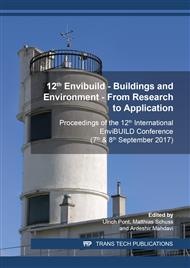[1]
D. Zirkelbach, S.-R. Mehra, K.-P. Sedlbauer, H.-M. Künzel, and B. Stöckl, A hygrothermal green roof model to simulate moisture and energy performance of building components, Energy and Buildings, vol. 145, pp.79-91, (2017).
DOI: 10.1016/j.enbuild.2017.04.001
Google Scholar
[2]
G. R. Finken, S. P. Bjarløv, and R. H. Peuhkuri, Effect of façade impregnation on feasibility of capillary active thermal internal insulation for a historic dormitory - a hygrothermal simulation study, Construction and Building Materials, vol. 113, pp.202-214, (2016).
DOI: 10.1016/j.conbuildmat.2016.03.019
Google Scholar
[3]
E. Marra, D. Zirkelbach, and H. Künzel, Prediction of steel corrosion in porous building materials by means of a new hygrothermal model, vol. 78, pp.1299-1304, 2015. cited By 1.
DOI: 10.1016/j.egypro.2015.11.144
Google Scholar
[4]
P. Baggio, C. Bonacina, and B. Schrefler, Some considerations on modeling heat and mass transfer in porous media, Transport in Porous Media, vol. 28, no. 3, pp.233-251, (1997).
DOI: 10.1023/a:1006525729566
Google Scholar
[5]
D. De Vries, Simultaneous transfer of heat and moisture in porous media, Eos, Transactions American Geophysical Union, vol. 39, no. 5, pp.909-916, (1958).
DOI: 10.1029/tr039i005p00909
Google Scholar
[6]
G. Comini and R. Lewis, A numerical solution of two-dimensional problems involving heat and mass transfer, International Journal of Heat and Mass Transfer, vol. 19, no. 12, pp.1387-1392, (1976).
DOI: 10.1016/0017-9310(76)90067-3
Google Scholar
[7]
A. W. van Schijndel, Multiphysics modeling of building physical constructions, in Building Simulation, vol. 4, pp.49-60, Springer, (2011).
DOI: 10.1007/s12273-011-0020-0
Google Scholar
[8]
O. Adan, H. Brocken, J. Carmeliet, H. Hens, S. Roels, and C.-E. Hagentoft, Determination of liquid water transfer properties of porous building materials and development of numerical assessment methods: Introduction to the ec hamstad project, Journal of Thermal Envelope and Building Science, vol. 27, no. 4, pp.253-260, (2004).
DOI: 10.1177/1097196304042323
Google Scholar
[9]
H. M. Künzel, Simultaneous heat and moisture transport in building components, One-and two-dimensional calculation using simple parameters. IRB-Verlag Stuttgart, (1995).
Google Scholar
[10]
H. Künzel, Moisture risk assessment of roof constructions by computer simulation in comparison to the standard glaser-method, in International Building Physics Conference, Eindhoven, pp.225-232, (2000).
Google Scholar
[11]
J. Van Der Kooi, Moisture transport in cellular concrete roofs. Uitgeverij Waltman, (1971).
Google Scholar
[12]
ASHRAE. International Weather for Energy Calculations (IWEC Weather Files) Users Manual and CD-ROM, Atlanta: ASHRAE. (2001).
Google Scholar
[13]
L. Mazzarella, Dati climatici G. De Giorgio, Proceedings of Giornata di Studio Giovanni De Giorgio, Politecnico di Milano, Milano, vol. 18, (1997).
Google Scholar


